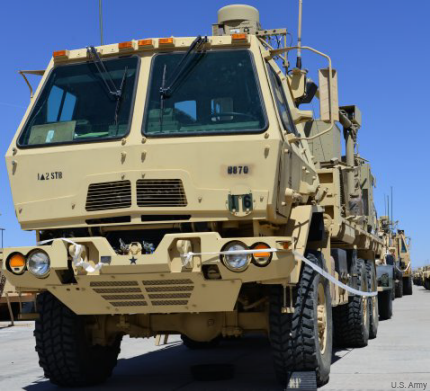
Three steps the Army can take toward multinational force interoperability
Achieving interoperability among global forces is no small feat; it requires a multi-pronged approach, SolarWinds’ Joel Dolisy writes.

An FMTV served as a communications node during this year’s Bold Quest exercise.
Never has the need been greater. Around the globe, the United States is and must work in tandem with strategic global partners to ensure the safety of our country and of our world. But doing so is no simple feat, and requires collaborative communications and modernized networks that allow our forces to work in lock-step with our allies.
Easier said than done, especially when you consider that our NATO partners may be working with communications systems 10 to 15 years older than our own. Some are using virtual “hand-me-down” equipment with big performance issues that can directly impact their ability to collaborate with other countries, including the United States.
The U.S. Army’s Multinational Force Interoperability plan is built to circumvent such challenges. The plan’s goal is straightforward: for U.S. forces to mitigate risks through better force management and increased military-to-military interoperability with allies and foreign partners. However, each country may have different technologies and protocols surrounding their networks – and that’s making things even more challenging.
Not a question of if, but when
The headlines of late are plastered with terror threats and the question of security, not just here at home, but on the global stage. This has dramatically increased the need for us to align with our allies, and to be ready for what lies ahead. To do so, communications amongst us all is paramount.
Maj. Gen. Bruce Crawford, commander of Army Communications-Electronics Command, has said that our direction depends on multinational interoperability, yet we are, at present, unprepared for that type of connectivity. Earlier this year, Crawford remarked “our entire strategy of regionally aligned forces and rotational forces depends on our ability to be interoperable from a multinational perspective. Yet if you’re in a division today and you’ve got a coalition interoperability issue … where do you take that?”
The effort must start in the only place we can truly control: our own networks.
Modernization at home, and around the world
Achieving interoperability among global forces is no small feat, and requires a multi-pronged approach. Because in most instances our allies lack modernized equipment and are years behind the U.S. systems, performance issues abound. Antiquated, slow systems can present huge challenges and directly impact the United States’ efforts toward maintaining effective collaboration.
Defense Department IT administrators may not be able to control how or when allied countries modernize their own networks. The best our country can do is to tackle the issue at home by creating modern and secure networks that can alleviate many of the issues that our allies’ systems may present. Here are three key steps.
• First, there needs to be network performance monitoring in place. There must be a system for identification of bottlenecks with antiquated technology, as these become truly time-consuming for IT personnel. A networking performance monitoring system will enable a quickened identification of the issue for a more timely resolution of the problem.
• Second, security must be taken into account. The need for interoperable communications with our allies carries a potential security risk. Security and event management software is an essential component to ensure that resources are shared and that any suspicious behavior triggers the needed management actions.
• Finally, troubleshooting. Alert generation and notification is a must if our forces are to circumvent communications issues in a timely fashion. Trouble-shooting is key, not just on the U.S. side, but also on the side of our NATO partners. Network trouble-shooting will enable a real, collaborative full picture to ensure that issues are identified and lags in communication resolved.
Other countries are, of course, working hard to modernize their own networks using similar technologies. For example, the British military is heavily investing in automated information management and collaboration systems through its ARRC C2IS initiative. And many countries, including Australia, Canada, France, and others, have worked with the U.S. military on so-called “Bold Quest” exercises designed to evaluate new technologies and test their interoperability and overall in-theater effectiveness.
One world, one network
To use a cliché, we’re all in this together. Different countries understand the heightened need for communications interoperability, and an international dialog is underway to make that a reality. We’re still far from the ultimate goal of “one world, one network.” But we’ve started building toward that future by eschewing legacy IT systems and implementing automated monitoring and security systems that can help bridge the gap between the DOD’s network and our allies’ systems.